Have you ever dreamed of living in a cozy and compact space that perfectly suits your needs? The idea of building a tiny home may have crossed your mind, but you may be hesitant due to the fear of making costly mistakes.
Well, fear not! In this ultimate guide to building a tiny home, we will delve into the common mistakes that can easily be avoided, ensuring that your journey to a dreamy and functional living space is smooth and successful.
Building a tiny home can be an incredibly rewarding experience, but it’s important to approach it with careful planning and consideration. Throughout this guide, we will explore various aspects of the building process, from assessing your needs and setting a budget to choosing the right location, designing the floor plan, and selecting the materials and construction methods that best suit your vision.
We will also provide insights on hiring professionals versus taking the do-it-yourself route, as well as tips for setting up essential systems and utilities. By the time you finish reading this guide, you’ll be equipped with the knowledge and confidence to embark on your own tiny home adventure, while avoiding the common pitfalls that can turn your dream into a nightmare.
So, let’s get started on this exciting journey and make your tiny home dreams a reality!
Key Takeaways
Contents
- 1 Assess Your Needs and Set a Budget
- 2 Choose the Right Location and Legal Considerations
- 3 Design and Floor Plan Considerations
- 4 Selecting the Right Materials and Construction Methods
- 5 Hiring Professionals and DIY Options
- 6 Navigating Permits and Legalities
- 7 Essential Systems and Utilities
- 8 Interior Design and Decor
- 9 Moving In and Settling into Your Tiny Home
- 10 Maintenance Tips Of Your Tiny Home
- 11 Conclusion
Assess Your Needs and Set a Budget

Now that you’ve decided to embark on the exciting journey of building your own tiny home, it’s time to assess your needs and set a budget that won’t break the bank!
Setting a timeline is crucial when it comes to building a tiny home. Determine how long you’re willing to spend on the project, as this will have an impact on your overall budget. If you have a tight deadline, you may need to hire professionals to help with the construction, which can add to the costs. On the other hand, if you have more time, you can opt for a slower, DIY approach, which can save you money. Consider your personal circumstances, such as work commitments and family responsibilities, to set a realistic timeline that fits your lifestyle.
Finding financing options is another important step in the process of building a tiny home. Before you start construction, it’s essential to have a clear idea of how much money you can allocate to the project. Research different financing options to determine which one works best for you. This could include personal savings, loans, or even crowdfunding. Take into account the interest rates, repayment terms, and any additional fees that may be involved. It’s also worth considering if you qualify for any grants or subsidies that could help offset the costs.
By carefully assessing your financial situation and exploring all available options, you can set a budget that allows you to build your dream tiny home without breaking the bank.
Choose the Right Location and Legal Considerations

When choosing the right location for your tiny home, there are several key points you need to consider.
Firstly, zoning and building codes play a crucial role in determining where you can legally place your tiny home.
You’ll also need to ensure that you have access to utilities such as water, electricity, and sewage.
Additionally, you should explore different options for land ownership and leasing to find the best fit for your needs and budget.
Zoning and Building Codes
Avoiding zoning and building code violations is crucial when building your tiny home. Failure to comply with these regulations can result in fines, legal issues, and even the demolition of your tiny home. To ensure a smooth and hassle-free construction process, here are four key points to keep in mind:
1. Research local zoning restrictions: Before starting any construction, familiarize yourself with the zoning regulations in your area. Different locations may have specific requirements for the size, height, and location of tiny homes. Some areas may not allow tiny homes at all. By understanding the zoning restrictions, you can avoid costly mistakes and ensure that your tiny home is compliant.
2. Obtain the necessary permits: Building codes vary from place to place, so it’s essential to obtain the required permits before starting construction. This may include permits for electrical, plumbing, and structural work. Working with a professional who’s familiar with local building codes can help you navigate the permit process and ensure that your tiny home meets all necessary requirements.
3. Follow building code guidelines: Building codes are designed to ensure the safety and well-being of occupants. Familiarize yourself with the specific building code guidelines in your area and incorporate them into your design and construction plans. This includes requirements for insulation, ventilation, fire safety, and structural integrity. By adhering to these guidelines, you can create a safe and comfortable living space that meets all necessary regulations.
4. Consult with professionals: Building a tiny home involves various technical aspects, and it’s advisable to consult with professionals who’re experienced in construction and zoning regulations. Architects, builders, and legal experts can provide valuable guidance throughout the process, helping you avoid common pitfalls and ensure that your tiny home is compliant with all necessary regulations.
By being diligent in your research, obtaining the proper permits, following building code guidelines, and seeking professional advice, you can navigate the zoning and building code requirements with ease. This won’t only save you from potential legal issues but also ensure that your tiny home is a safe and comfortable living space.
Access to Utilities
To make your tiny home living dreams a reality, ensuring access to utilities is essential. One of the challenges of building a tiny home is finding off-grid options for utilities.
While many traditional homes are connected to the electrical grid, water supply, and sewer system, tiny homes often require alternative solutions. However, there are cost-effective options available that can provide you with the necessary utilities without breaking the bank.
When it comes to electricity, solar power is a popular and sustainable option for tiny homes. Installing solar panels on the roof of your tiny home can generate enough electricity to power your appliances and electronics. Additionally, you can invest in a battery storage system to store excess energy for use during cloudy days or at night. This off-grid option not only reduces your reliance on traditional power sources but also saves you money in the long run.
For water supply and waste management, there are several cost-effective solutions available. Rainwater harvesting systems can collect and store rainwater for various household uses such as flushing toilets, watering plants, and even showering. Composting toilets are another popular option for tiny homes as they don’t require water or a connection to the sewer system. These toilets break down waste into compost, which can be used as fertilizer for plants. These off-grid options not only provide you with the necessary utilities but also promote sustainability and self-sufficiency in your tiny home living.
By exploring off-grid options and cost-effective solutions, you can ensure access to utilities in your tiny home without relying on traditional infrastructure. Solar power, rainwater harvesting, and composting toilets are just a few examples of the alternatives available to make your tiny home living comfortable and sustainable.
With careful planning and research, you can enjoy the benefits of a tiny home lifestyle while minimizing your environmental impact and reducing utility costs.
Land Ownership and Leasing Options
If you’re considering land ownership for your tiny home, there are various leasing options available to suit your needs and budget. One option is to lease land from a private owner. This can be a great choice if you want more control over the location and design of your tiny home. You can negotiate the terms of the lease directly with the owner, allowing for flexibility in terms of rent, lease duration, and any restrictions or requirements.
However, it’s important to thoroughly research and vet the owner before entering into a lease agreement to ensure they have the legal right to lease the land and that there are no hidden issues or conflicts.
Another leasing option is to lease land from a community or organization that specializes in tiny home living. These communities are specifically designed to accommodate tiny homes and often provide amenities such as utilities, communal spaces, and social activities. Leasing land from a tiny home community can be advantageous as it offers a sense of community and support from like-minded individuals. Additionally, these communities may have established relationships with local authorities, making it easier to navigate zoning and building code regulations.
However, it’s important to carefully review the terms of the lease agreement to ensure it aligns with your goals and preferences, as some communities may have restrictions on the size, design, or appearance of your tiny home.
Design and Floor Plan Considerations
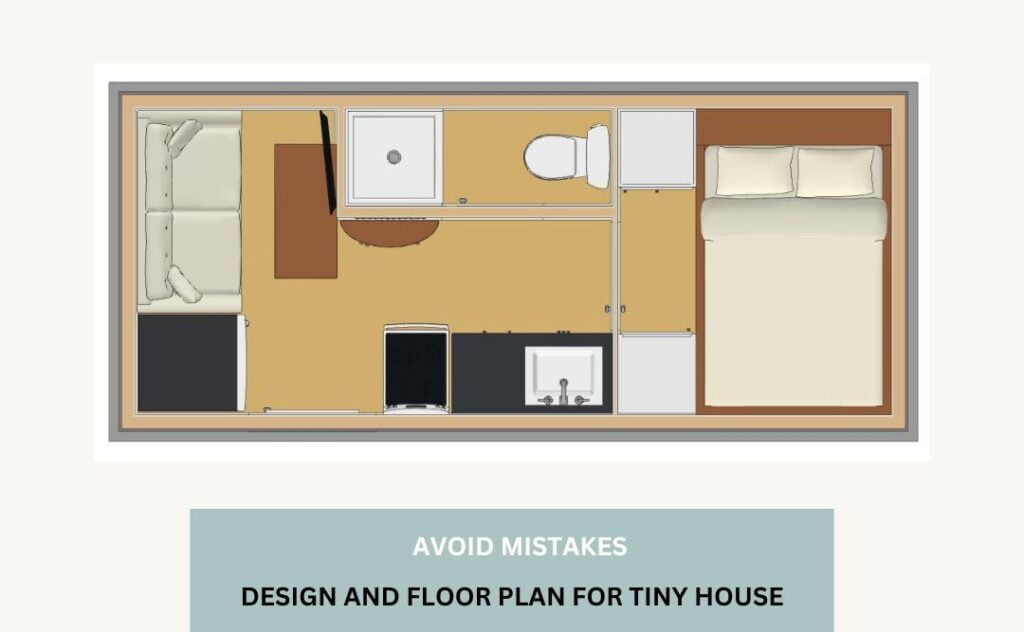
Creating a cozy and functional living space is essential when designing a tiny home, ensuring that every square inch is utilized to its fullest potential. When it comes to floor plan optimization, there are a few key considerations to keep in mind.
First and foremost, think about the flow of the space. It’s important to create a layout that allows for easy movement and avoids any unnecessary obstacles. Consider the placement of doors, windows, and furniture to maximize the usable space. Additionally, think about how you can incorporate multi-purpose furniture or built-in storage solutions to make the most of the limited square footage. For example, opt for a loft bed with built-in drawers or utilize under-stair storage.
By carefully considering the placement of each element in your floor plan, you can create a functional and efficient living space.
Maximizing storage is another crucial aspect of designing a tiny home. With limited square footage, it’s important to get creative with storage solutions. Here are four ideas to help you make the most of your space:
1. Utilize vertical space: Install shelving or cabinets that reach all the way up to the ceiling. This will allow you to store items that are used less frequently or are seasonal.
2. Incorporate hidden storage: Look for opportunities to add concealed storage compartments in unexpected places, such as under benches, within stairs, or behind wall panels. This will help keep your space clutter-free while maximizing storage capacity.
3. Opt for multi-purpose furniture: Invest in furniture pieces that serve multiple functions, such as a coffee table with hidden storage or a sofa that can be converted into a bed. This will help you save space without sacrificing functionality.
4. Use hooks and organizers: Install hooks on walls or behind doors to hang items like coats, bags, and kitchen utensils. Additionally, invest in organizers for your closet or pantry to maximize storage capacity and keep items neatly organized.
By considering floor plan optimization and maximizing storage, you can create a tiny home that is both functional and comfortable, making the most of every square inch.
Selecting the Right Materials and Construction Methods
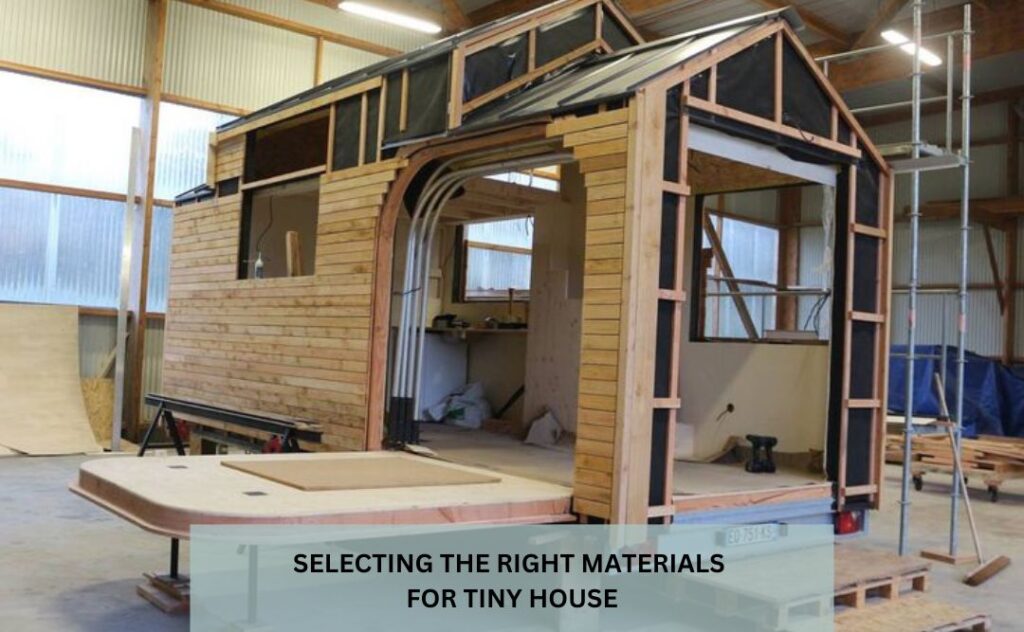
Now that you’ve considered the design and floor plan of your tiny home, it’s time to move on to the next crucial step: selecting the right materials and construction methods.
When it comes to building a tiny home, it’s important to choose sustainable materials and efficient construction methods. These choices will not only ensure durability but also minimize environmental impact.
One of the key aspects of building a sustainable tiny home is using eco-friendly materials. Opt for materials that are renewable, recycled, or locally sourced. This can significantly reduce your carbon footprint. For example, you can choose to use reclaimed wood for your flooring or countertops. It not only adds character to your home but also reduces the demand for new materials. Additionally, utilizing insulation materials made from recycled materials can help regulate the temperature inside your tiny home and reduce energy consumption.
Efficient construction methods are also essential when building a tiny home. Since space is limited, it’s crucial to maximize every square inch and make efficient use of resources. Prefabrication and modular construction techniques can be particularly advantageous in this regard. By using pre-built components, you can minimize construction waste and save time and money. Additionally, incorporating energy-efficient features such as solar panels, double-glazed windows, and high-quality insulation can help reduce your energy consumption and create a more sustainable living environment.
By carefully selecting sustainable materials and employing efficient construction methods, you can create a tiny home that not only meets your needs but also aligns with your environmental values. Remember to research and consult with professionals to ensure that you make informed choices that’ll result in a well-built and eco-friendly tiny home.
Hiring Professionals and DIY Options

When it comes to hiring professionals for your tiny home project, it’s important to find a contractor or builder who understands the unique challenges and requirements of building a small space.
Look for someone with experience in tiny home construction and a portfolio that showcases their previous work.
If you’re considering taking on the project yourself, there are plenty of DIY building and construction tips available to help you along the way.
Additionally, collaborating with architects and designers can ensure that your tiny home is not only functional but also aesthetically pleasing.
Hiring a Contractor or Builder
Hiring a contractor or builder can be a game-changer for your tiny home project, as they bring the expertise needed to avoid common mistakes. When considering this option, there are several cost considerations to keep in mind.
While hiring a contractor may seem expensive at first, it can actually save you money in the long run. They have the knowledge and experience to source materials at a better price, and they can also help you avoid costly mistakes that could arise from DIY building options. Additionally, a contractor can provide you with a construction timeline, ensuring that your project stays on track and is completed in a timely manner.
Finding reputable contractors is essential for ensuring a successful build. Start by asking friends, family, or neighbors for recommendations. You can also search online for contractors who specialize in tiny home construction.
Once you have a few potential candidates, be sure to check their credentials, such as licenses and insurance. It’s also important to communicate openly and frequently with your chosen contractor. Clearly discuss your expectations and goals for the project, and make sure they understand your vision. Regular communication throughout the construction process will help to avoid misunderstandings and ensure that your tiny home is built to your specifications.
DIY Building and Construction Tips
If you’re considering taking on the construction of your tiny home yourself, keep in mind that DIY builders account for over 70% of all tiny home projects. This means that you’re not alone in wanting to tackle this project on your own.
DIY building techniques can be a great way to save money and have complete control over the design and construction process of your tiny home.
When it comes to DIY building and construction, there are a few cost-saving strategies you should keep in mind. First, consider salvaging materials whenever possible. You’d be surprised at how many high-quality materials can be found at salvage yards or through online marketplaces. By repurposing materials, you can save a significant amount of money while adding unique character to your tiny home.
Additionally, it’s important to plan your project carefully and take your time. Rushing through the construction process can lead to mistakes and costly repairs later on. Take the time to research building techniques, consult with professionals if needed, and create a detailed plan before you start construction. This will help ensure that your DIY project is successful and within your budget.
Collaborating with Architects and Designers
Collaborating with architects and designers can bring a fresh perspective and creative ideas to the construction of your DIY tiny abode. By working together, you can benefit from their expertise and experience in creating functional and aesthetically pleasing spaces.
Architects and designers can help you optimize the layout of your tiny home, making the most of every inch of space and ensuring that it meets your specific needs and preferences. One of the key benefits of collaborating with architects and designers is the opportunity for creative collaboration. They can offer innovative solutions and design ideas that you may not have considered on your own. Their training and experience in architectural design can help you create a tiny home that is not only functional but also visually appealing.
Working with professionals in this field can also ensure that your DIY project meets building codes and regulations, avoiding any potential legal issues down the line. However, it’s important to acknowledge that there can be communication challenges when collaborating with architects and designers. It’s crucial to clearly communicate your vision, needs, and budget to avoid any misunderstandings.
Regular and open communication throughout the design and construction process is key to ensuring that everyone is on the same page. Additionally, collaborating with professionals may come with a cost, so it’s important to establish a budget and discuss fees upfront. Despite these challenges, collaborating with architects and designers can greatly enhance the outcome of your DIY tiny home project, resulting in a space that is both functional and visually appealing.
Before beginning the process of permits and legalities, be prepared to persevere through the paperwork and potential pitfalls. Building a tiny home requires careful attention to permit requirements and legal restrictions.
Each jurisdiction has its own set of rules and regulations regarding the construction of a dwelling, even if it’s on a smaller scale. It’s essential to familiarize yourself with these requirements before starting any construction.
Permit requirements for tiny homes can vary significantly depending on where you plan to build. Some areas may have specific size limitations, while others may require certain amenities or safety features. It’s crucial to research and understand these requirements to ensure that your tiny home meets all necessary standards.
Additionally, you may need to obtain permits for aspects such as plumbing, electrical work, and septic systems. Failure to comply with these regulations can result in fines or even the demolition of your tiny home.
Legal restrictions are another factor to consider when building a tiny home. Zoning laws may dictate where you can park or place your tiny home, whether it be on a permanent foundation or on wheels. Some areas may permit tiny homes as accessory dwelling units, while others may limit their use to specific zones. It’s essential to consult local zoning ordinances and building codes to ensure that you’re in compliance with the law.
Additionally, homeowners’ associations or neighborhood covenants may have their own restrictions on tiny homes, so it’s crucial to review any applicable regulations before proceeding.
By understanding and navigating the permits and legalities involved in building a tiny home, you can avoid unnecessary setbacks and ensure that your project is both legal and successful.
Essential Systems and Utilities
When it comes to electrical wiring and plumbing for your tiny home, it’s crucial to ensure that everything is done correctly and safely.
You’ll need to understand the specific requirements and codes for your area, as well as the best practices for installation.
Additionally, choosing the right heating and cooling options is essential for creating a comfortable living environment in your tiny home.
Whether you opt for a traditional HVAC system or explore alternative options like radiant floor heating or mini-split systems, understanding the pros and cons of each will help you make an informed decision.
Lastly, water and waste management are important considerations for any home, and even more so for a tiny home with limited space.
From selecting the right water storage and filtration systems to implementing efficient waste management solutions, careful planning and knowledge are key to ensuring a sustainable and functional setup.
Electrical Wiring and Plumbing
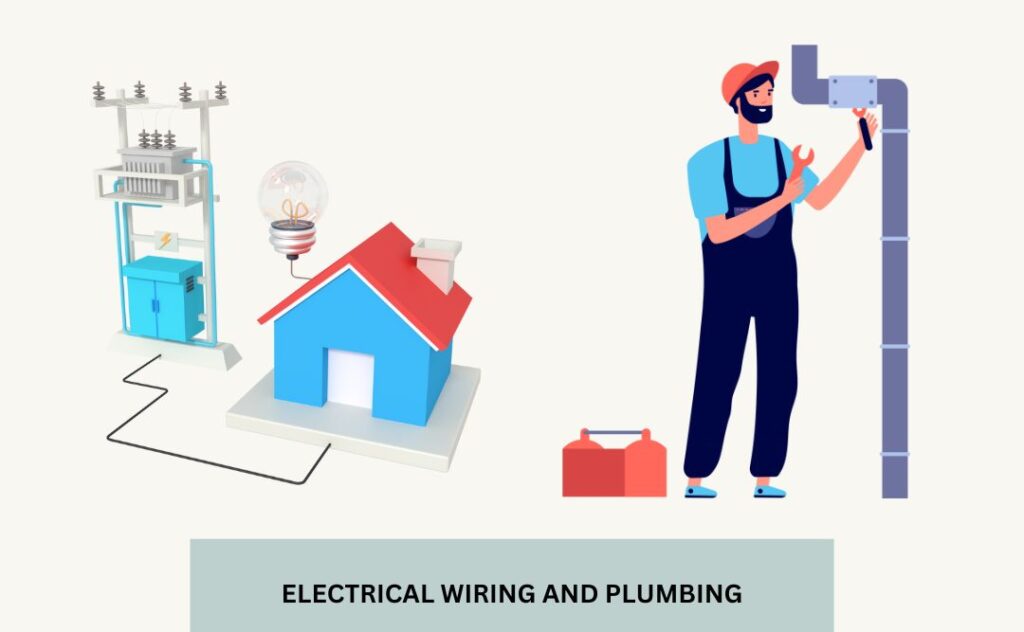
To ensure a successful build, don’t overlook the importance of properly installing electrical wiring and plumbing in your tiny home. These systems are crucial for functionality and comfort, so it’s essential to pay attention to the details.
Here are three key considerations to keep in mind when it comes to electrical wiring and plumbing:
1. Electrical safety: Safety should be your top priority when it comes to electrical wiring. Make sure you hire a licensed electrician who’s experienced in working with tiny homes. They’ll ensure that the wiring is up to code and properly grounded to prevent any electrical hazards. Additionally, consider installing a ground fault circuit interrupter (GFCI) outlet in areas where water may be present, such as the kitchen and bathroom, to protect against shocks.
2. Plumbing fixtures: Choosing the right plumbing fixtures is essential for maximizing space and functionality in your tiny home. Opt for compact and efficient fixtures designed for small spaces. Consider installing low-flow toilets and faucets to conserve water and reduce your environmental footprint. It’s also important to properly insulate your plumbing to prevent freezing during cold weather.
3. Layout and accessibility: Plan the layout of your electrical wiring and plumbing carefully to ensure easy access and maintenance. Keep in mind that space is limited in a tiny home, so consider placing your electrical panel and plumbing manifold in easily accessible locations. Label all circuits and pipes clearly for future reference and troubleshooting. Additionally, use flexible conduit and PEX piping to accommodate any movement or shifting that may occur in a mobile tiny home.
By paying attention to electrical safety and carefully planning the layout of your plumbing fixtures, you can avoid common mistakes and ensure a smooth and functional electrical and plumbing system in your tiny home. Remember to consult with professionals and do thorough research to make informed decisions for your specific needs.
Heating and Cooling Options
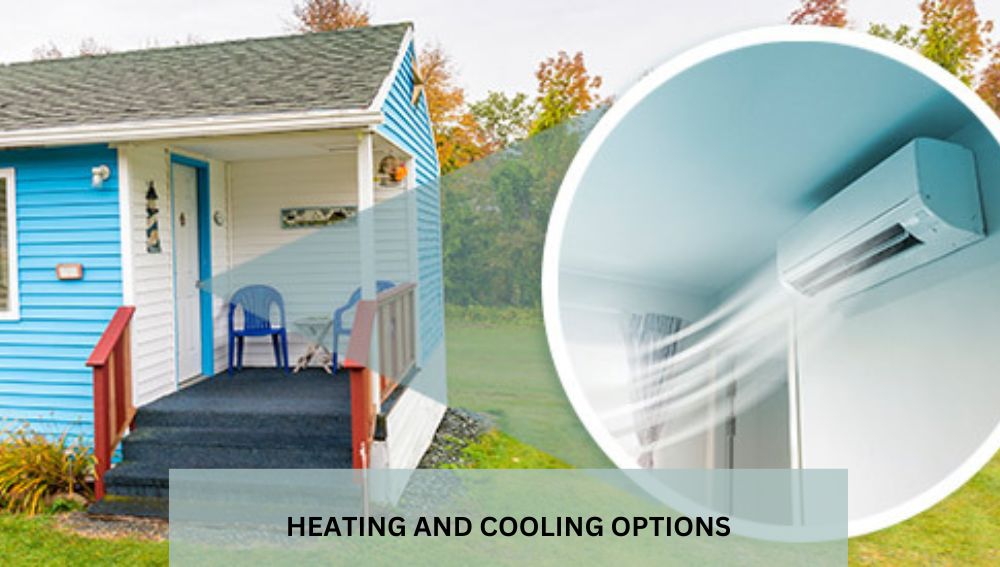
One key aspect to consider when designing your compact living space is the range of heating and cooling options available to ensure optimal comfort throughout the year.
In a tiny home, it’s crucial to find efficient solutions that not only provide the desired temperature but also minimize energy consumption. Two popular options to consider are geothermal heating and solar cooling.
Geothermal heating is an excellent choice for tiny homes as it harnesses the earth’s natural heat to warm your space. This system works by using pipes buried underground to circulate a fluid that absorbs heat from the ground. The fluid then travels to a heat pump, which extracts the heat and distributes it throughout your tiny home. Geothermal heating is highly efficient and environmentally friendly, as it relies on a renewable energy source. Additionally, it can save you money in the long run since its energy consumption is significantly lower compared to traditional heating systems.
Another option to consider for cooling your tiny home is solar cooling. Solar cooling utilizes the power of the sun to reduce the temperature inside your living space. This system works by using tiny house solar to generate electricity, which is then used to power an air conditioning unit or a fan. By harnessing the sun’s energy, you can keep your tiny home cool without relying on traditional grid-powered air conditioning systems. Solar cooling not only reduces your energy consumption but also decreases your carbon footprint, making it an eco-friendly choice for cooling your compact living space.
Incorporating geothermal heating and solar cooling into your tiny home design can provide you with efficient and sustainable solutions for maintaining a comfortable living environment throughout the year. By utilizing the earth’s natural heat and the power of the sun, you can create a cozy and eco-friendly space that ensures optimal comfort while minimizing energy consumption.
Consider these options when planning your heating and cooling systems to make the most of your tiny home experience.
Water and Waste Management
A crucial element in creating a sustainable and harmonious compact living space is effectively managing water and waste. When it comes to toilets, composting toilets are an excellent choice for tiny homes. These innovative systems break down human waste through natural processes, turning it into compost that can be used as fertilizer.
Composting toilets are not only eco-friendly, but they also eliminate the need for a traditional water-flushing system, saving precious resources in the process. Additionally, they require very little maintenance and can be installed in small spaces, making them ideal for tiny homes.
Another important aspect of water and waste management in a tiny home is the implementation of greywater systems. Greywater refers to wastewater from sources such as sinks, showers, and washing machines. Instead of letting this water go to waste, a greywater system collects and filters it, allowing it to be reused for non-potable purposes such as irrigation or flushing toilets.
By utilizing greywater, tiny homeowners can significantly reduce their water consumption and lessen their impact on the environment. It’s important to note that proper installation and maintenance of greywater systems are crucial to ensure their efficiency and prevent any potential health hazards.
Interior Design and Decor
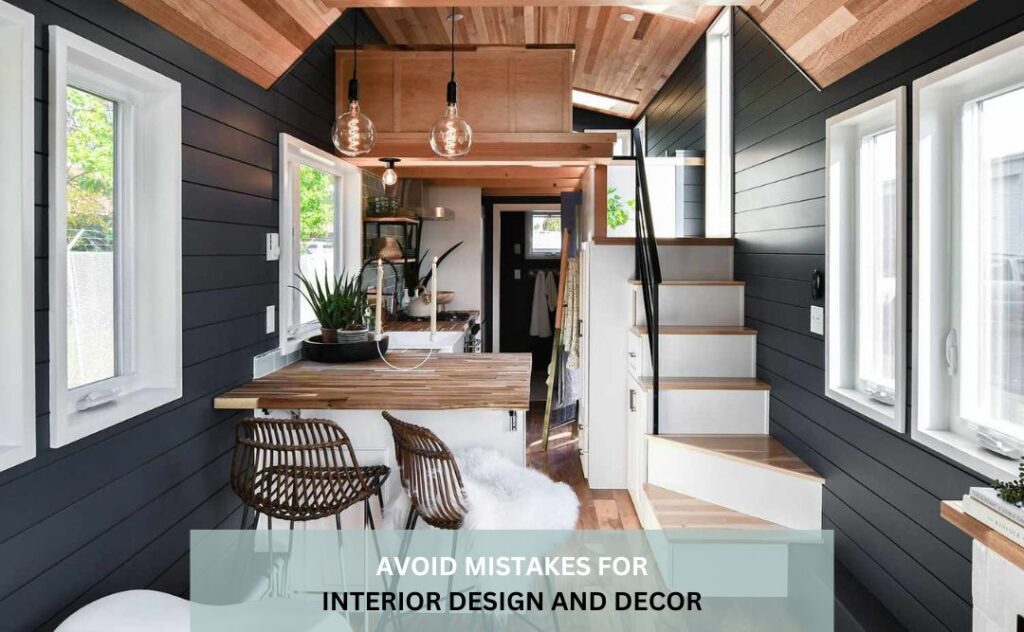
When it comes to interior design and decor for your tiny home, there are three key points to consider: functional and aesthetic choices, space-saving strategies, and personalizing your space.
You’ll want to carefully select furniture and decor that serve multiple purposes and maximize the limited space available. Additionally, implementing clever storage solutions and utilizing vertical space can help optimize your tiny home.
Lastly, don’t forget to infuse your own personal style and preferences into the design, making it a true reflection of your personality and creating a cozy and inviting atmosphere.
Functional and Aesthetic Choices
Make sure you consider both functionality and aesthetics when making choices for your tiny home, as it’ll play a significant role in creating a space that you’ll love living in.
In a small living space, every inch matters, so it’s crucial to maximize functional storage options. Look for furniture pieces that serve multiple purposes, such as a sofa that can also be converted into a bed or a coffee table with hidden storage compartments. Utilize vertical space by installing shelves, hooks, and cabinets on walls to keep your belongings organized and easily accessible.
Additionally, consider incorporating built-in storage solutions, like under-bed drawers or hidden compartments in the stairs, to make the most of every nook and cranny. By prioritizing functional storage, you’ll be able to keep your tiny home clutter-free and make the most of your limited space.
In addition to functional storage, sustainable design should also be a key consideration when making choices for your tiny home. Opt for eco-friendly materials, such as reclaimed wood or bamboo, which aren’t only environmentally friendly but also add a touch of natural beauty to your space. Invest in energy-efficient appliances and fixtures to minimize your carbon footprint and reduce utility costs.
Consider installing solar panels to harness renewable energy and reduce your dependence on the grid. Incorporate proper insulation, double-glazed windows, and efficient heating and cooling systems to ensure energy efficiency and comfortable living all year round. By making sustainable choices, you’ll not only contribute to a greener future but also create a healthier and more cost-effective living environment in your tiny home.
Space-Saving Strategies
Get creative with your space by utilizing innovative storage solutions and clever design techniques to make the most of your tiny home. One of the key elements to maximize space in a tiny home is choosing space-saving furniture. Look for furniture that serves multiple purposes, such as a sofa that can also be converted into a bed, or a dining table that can be folded down when not in use. This way, you can have all the necessary furniture without sacrificing valuable floor space.
Additionally, consider incorporating built-in storage solutions, such as hidden compartments under the stairs or a loft bed with built-in drawers. These clever design choices can help you make the most of every inch in your tiny home.
In addition to space-saving furniture, organization hacks can also play a big role in optimizing your small living space. Take advantage of vertical space by installing shelves or hooks on the walls to store items like books, kitchen utensils, or even clothing. You can also make use of unused spaces, such as the area under the bed or the back of doors, by adding storage containers or hanging organizers.
Another smart organization hack is to use see-through containers or labeled bins to easily locate and access your belongings. By implementing these organization strategies, you can keep your tiny home clutter-free and create a sense of spaciousness, even in a limited area.
With the right furniture and organization hacks, you can transform your tiny home into a functional and stylish living space.
Personalizing Your Tiny Home
Once you step foot into your tiny home, you’ll be amazed at the endless possibilities for personalization that’ll make it uniquely yours.
Despite the limited space, there are numerous customization options available that can transform your tiny home into a reflection of your personality and style. From the choice of furniture to the color palette, every detail can be tailored to suit your preferences and create a cozy, inviting space.
To add personal touches to your tiny home, consider the following options:
Wall Decals: These removable stickers are an easy and affordable way to add personality to your walls. Whether you prefer inspirational quotes, nature scenes, or abstract designs, wall decals offer a wide range of choices.
Unique Storage Solutions: Personalize your tiny home by incorporating creative storage options. From built-in shelves to hidden compartments, there are endless possibilities to optimize the use of space while adding a touch of style.
Customized Furniture: Invest in furniture pieces that not only fit the dimensions of your tiny home but also reflect your personal taste. Look for multi-functional furniture that serves multiple purposes, such as a sofa that can also be converted into a bed or a dining table that can be folded away when not in use.
By exploring these customization options and adding personal touches, you can transform your tiny home into a haven that truly feels like your own.
Remember to prioritize functionality and organization while infusing your unique style to create a space that’s both practical and aesthetically pleasing.
Moving In and Settling into Your Tiny Home
As you step through the front door of your cozy tiny home, you can’t help but feel a sense of contentment wash over you, knowing that this is the place where you’ll settle into a simpler, more intentional way of living.
Moving into a tiny home is a significant lifestyle change, and it’s important to give yourself time to settle in and adjust. One of the first things you’ll notice is the limited space, which may initially feel restrictive. However, with a bit of creativity and organization, you’ll find that every square inch of your tiny home can be utilized efficiently.
To make the most of your new living space, start by decluttering and only keeping the essentials. Embrace a minimalist mindset and let go of items that no longer serve a purpose in your life. This will not only create more physical space but also contribute to a sense of calm and tranquility.
As you settle into your tiny home, you’ll also need to adjust your daily routines and habits. For example, meal preparation may require more thought and planning in a smaller kitchen. Consider adopting a simplified meal plan or meal prepping to save time and make the most of your limited kitchen space.
Likewise, your storage solutions may need to be more creative, utilizing vertical space and multi-functional furniture. By embracing these adjustments and adapting your lifestyle, you’ll soon find that living in a tiny home can be incredibly rewarding and fulfilling.
Maintenance Tips Of Your Tiny Home
When it comes to the maintenance of your tiny home, there are three key points to focus on: cleaning and storage solutions, weatherproofing and insulation, and troubleshooting common issues.
Keeping your tiny home clean and organized is essential for maximizing space and preventing clutter.
Weatherproofing and insulation are crucial to ensure your home stays comfortable and energy-efficient in all seasons.
Lastly, knowing how to troubleshoot and address common issues that may arise will help you maintain a smooth and stress-free living experience in your tiny home.
Cleaning and Storage Solutions
Tackle the challenge of keeping your tiny home organized with clever cleaning and storage solutions that’ll make you feel like a master of space.
When it comes to cleaning your tiny home, efficiency’s key. Start by decluttering regularly, as it’s easy for a small space to feel crowded and messy.
Utilize vertical storage options such as wall-mounted shelves and hooks to maximize your space. Invest in collapsible furniture and storage bins that can easily be tucked away when not in use. This’ll help you maintain a clean and tidy living environment without sacrificing valuable square footage.
In terms of cleaning tips, it’s important to establish a routine. Dedicate specific days or times each week to tackle different cleaning tasks, such as dusting, vacuuming, and mopping. Opt for multi-purpose cleaning products to save space and simplify your cleaning routine.
Use storage solutions that serve dual purposes, such as ottomans or benches with hidden storage compartments. This way, you can store items while also providing additional seating or a place to put your feet up.
Lastly, make use of door organizers, hanging shoe racks, and under-bed storage bins to maximize every inch of your tiny home. By implementing these cleaning and storage solutions, you can keep your tiny home organized and clutter-free, ensuring a peaceful and enjoyable living space.
Weatherproofing and Insulation
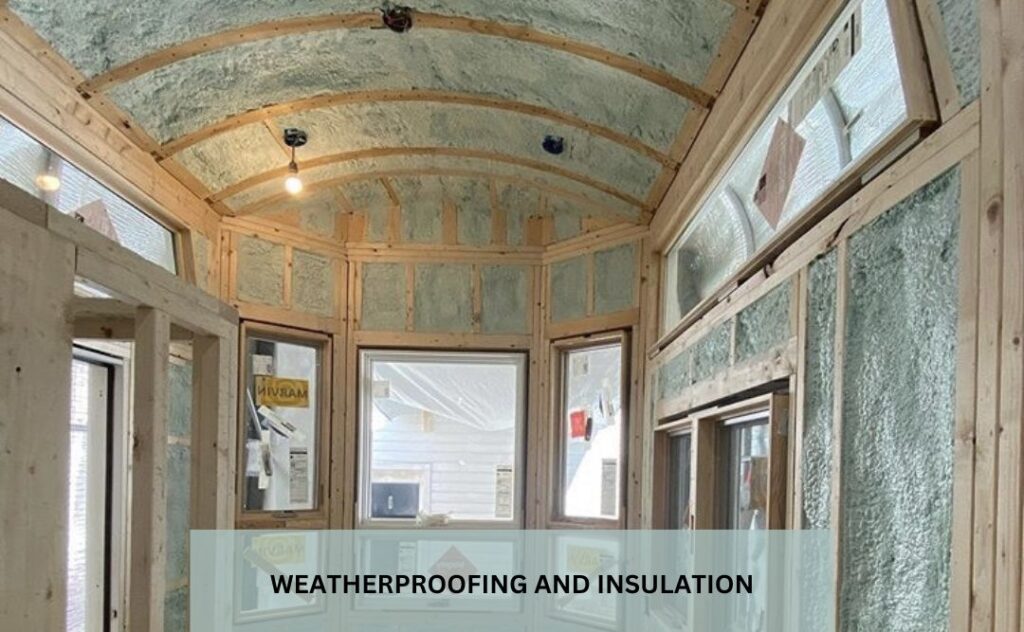
Ensure that your cozy haven is protected from the elements with effective weatherproofing and insulation techniques. Weatherproofing is crucial to prevent leaks, drafts, and moisture from seeping into your tiny home.
One of the most effective weatherproofing techniques is sealing all gaps and cracks in your home’s exterior using caulk or weatherstripping. Pay close attention to areas around windows, doors, and vents as these are common entry points for air and water.
Additionally, consider using a high-quality weatherproofing membrane or barrier on your home’s exterior walls and roof to provide an extra layer of protection against rain and wind. This will help to keep your tiny home dry and comfortable, no matter what the weather outside.
When it comes to insulation materials, there are several options to choose from based on your needs and budget. One popular choice for tiny homes is spray foam insulation, which provides excellent thermal insulation and helps to seal any gaps or cracks in the walls.
Another option is fiberglass insulation, which is more affordable and widely available. It comes in batts or rolls and can be easily installed between wall studs and in the attic.
If you’re looking for a more eco-friendly option, consider using natural insulation materials such as cellulose or sheep’s wool. These materials are sustainable, non-toxic, and have excellent thermal properties.
Whichever insulation material you choose, make sure to install it properly to maximize its effectiveness and ensure a well-insulated and energy-efficient tiny home.
Troubleshooting Common Issues
To troubleshoot common issues, you can rely on simple yet effective solutions to keep your cozy haven in top shape.
One of the most common troubleshooting techniques is to identify the root cause of the problem. Whether it’s a leaky roof, faulty electrical wiring, or plumbing issues, understanding the source of the problem is crucial in finding the right solution.
Take the time to inspect your tiny home thoroughly and look for any signs of damage or malfunction. This could include checking for water stains on the ceiling, testing outlets and switches for any electrical issues, or inspecting pipes and faucets for leaks. By pinpointing the exact problem, you can save yourself time and money by addressing it directly.
Another common issue that can arise when building a tiny home is construction delays. It’s important to be prepared for unexpected setbacks that may occur during the construction process.
One way to deal with construction delays is to have a contingency plan in place. This could involve setting aside extra time and resources to account for any unexpected obstacles that may arise.
Additionally, communication is key when it comes to dealing with construction delays. Stay in constant contact with your contractors and suppliers to ensure that everyone is on the same page and that any potential delays are addressed promptly.
By taking a proactive approach and being prepared for potential setbacks, you can navigate through construction delays with ease and keep your tiny home project on track.
Conclusion
In conclusion, building a tiny home is an exciting and rewarding endeavor that can provide you with a cozy and sustainable living space. Throughout this ultimate guide, you’ve learned about the importance of assessing your needs and setting a budget, choosing the right location, and considering legal requirements.
You’ve also gained insight into designing the perfect floor plan, selecting the right materials, and utilizing efficient construction methods. By hiring professionals or embarking on a DIY journey, you can bring your tiny home dreams to life. Remember to prioritize essential systems and utilities, ensuring that your home is functional and comfortable.
And don’t forget about the interior design and décor, which will add personality and charm to your tiny abode. As you move in and settle into your tiny home, you’ll discover the joys of minimalism and the freedom that comes with living in a smaller space.
Embrace the simplicity and find creative storage solutions to make the most of every inch. And don’t worry, maintenance and upkeep won’t be a burden if you stay proactive and follow the tips provided.
In conclusion, building a tiny home is a journey that requires careful planning and consideration, but the end result is worth every effort. So, go ahead and start building your dream tiny home – a cozy haven where you can live comfortably and sustainably. With the knowledge and insights gained from this guide, you can avoid common mistakes and create a space that reflects your unique personality and meets your needs.
Happy building!

